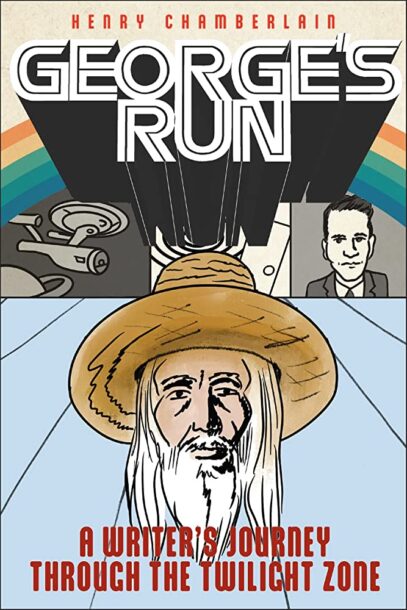 By HENRY CHAMBERLAIN (Rutgers University Press; 2023)
By HENRY CHAMBERLAIN (Rutgers University Press; 2023)
Who was George Clayton Johnson (1929-2015)? He was one of the lesser known members of “The Group” corralled by Rod Sterling to write for the original TWILIGHT ZONE. The more prominent members of The Group included Charles Beaumont, Richard Matheson, Ray Russell and William F. Nolan, into whose ranks Johnson, an eighth grade dropout and proto-hippie from Wyoming, “learned and earned my way in.” Johnson subsequently wrote quite extensively for STAR TREK and co-drafted (with Nolan) the 1967 sci fi novel LOGAN’S RUN, which was made into the famous 1976 flick of the same name. That’s not a hugely extensive bibliography, but a substantial one nonetheless.
GEORGE’S RUN, the first book to be devoted exclusively to George Clayton Johnson, is drafted in the form of a graphic novel. The writer and illustrator was Henry Chamberlain, a podcaster who became determined to profile Johnson after interviewing him for his podcast.
Chamberlain eagerly inserts himself into the book by dramatizing his 2014 meetings with Johnson. According to what’s set down here, these two men were kindred spirits, sharing identical interests, hang-ups and political views—which Chamberlain makes sure to broadcast in the form of rants on the evils of Donald Trump and the importance of marijuana legalization (a topic near and dear to the heart of Johnson, at whose funeral, Chamberlain claims, a cannabis activist was stationed to hand out joints).
Johnson’s path to THE TWILIGHT ZONE was, unexpectedly enough, initiated by Frank Sinatra. Johnson was the co-scripter of the 1960 Sinatra vehicle OCEAN’S ELEVEN, for which Johnson nearly didn’t get a writing credit–an issue he fixed by making a direct appeal to Sinatra. Beyond that Johnson’s life story isn’t as interesting or eventful as you might expect. He married in 1952, enjoying a “happy home for the rest of his life” (zzzzzzzzzzzzz), and inspired Chamberlain to pursue his own path: “Thanks to George, I will proudly keep on dreaming.”
Chamberlain’s artwork isn’t exactly award-worthy, being crude and slapdash (aside from Johnson, who’s generally depicted sporting a beard and top hat, all the characters look alike), although it does have an agreeably homemade charm. The book’s major problem is its dialogue, which is arch and clichéd (sample line: “George, your time will come. You have skill and heart”), bearing a definite condensed-to-fit-the-dialogue-balloons feel. This begs the question of why this book was even presented in graphic novel, and not textual (in which rendering it would have worked fine), form. As GEORGE’S RUN stands I recommend it, but not too highly.
